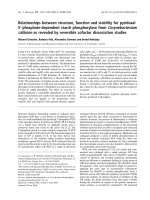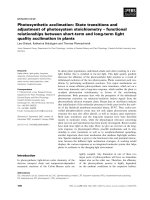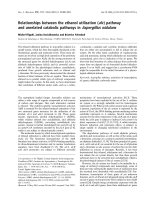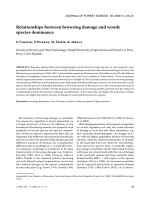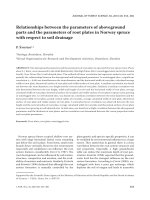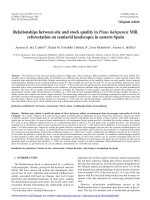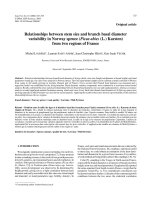Relationships between vietnams stock prices and united statess stock prices, exchange rates, gold prices, crude oil prices
Bạn đang xem bản rút gọn của tài liệu. Xem và tải ngay bản đầy đủ của tài liệu tại đây (229.93 KB, 50 trang )
MINISTRY OF EDUCATION AND TRAINING
UNIVERSITY OF ECONOMICS HOCHIMINH CITY
--- oOo ---
ĐỖ NGỌC ANH
RELATIONSHIPS BETWEEN VIETNAM’S STOCK PRICES
AND UNITED STATES’ STOCK PRICES, EXCHANGE
RATES, GOLD PRICES, CRUDE OIL PRICES
MASTER THESIS
Ho Chi Minh City – 2011
MINISTRY OF EDUCATION AND TRAINING
UNIVERSITY OF ECONOMICS HOCHIMINH CITY
----------o0o---------
ĐỖ NGỌC ANH
RELATIONSHIPS BETWEEN VIETNAM’S STOCK PRICES
AND UNITED STATES’ STOCK PRICES, EXCHANGE
RATES, GOLD PRICES, CRUDE OIL PRICES
MAJOR: BANKING AND FINANCE
MAJOR CODE: 60.31.12
MASTER THESIS
INSTRUCTOR: Dr. VÕ XUÂN VINH
Ho Chi Minh City – 2011
i
ACKNOWLEDGEMENTS
First of all, I would like to express my deep gratitude to Dr. Vo Xuan Vinh
for his kind supervising my thesis work, providing sources, especially software,
documents related to this thesis, and giving me invaluable instructions and criticism.
Throughout my thesis preparation, Dr. Vinh provided great encouragement and
teaching.
I would like to thank all the authors of many reference sources for providing
many precious theories, ideas as important input of my research.
I am also grateful to the professors and visiting lecturers of University of
Economics Hochiminh City for the enthusiasm and expertise to transfer me the
invaluable knowledge and insights during the MBA courses.
I want to extend my appreciation to my classmates, my friends who make
great contribution in collecting data and give me encouragement. Without their help
and sharing, I could not successfully complete this MBA program and the thesis.
Finally, special thanks are for my colleagues and my family, who have
understood, encouraged and created as much better conditions as possible for me to
continue studying until the end of the course and completing this thesis.
ii
ABTRACT
The thesis investigates the relationships between Vietnam’s stock prices and
the US’ stock prices, foreign exchange rates, gold prices, crude oil prices. Using the
daily data from 2005 to 2010, the results indicate that Vietnam’s stock prices are
influenced by crude oil prices. In addition, Vietnam’s stock prices are also affected
significantly by US’ stock prices, foreign exchange rates over the period before the
2008 Global Financial Crisis. There are evidences that Vietnam’s stock prices are
highly correlated with US’ stock prices, foreign exchange rates and gold prices for
the same period. Furthermore, Vietnam’s stock prices are cointegrated with US’s
stock prices before and after the crisis, foreign exchange rates, gold prices and crude
oil prices just during and after the crisis.
Keywords: Vietnam’s stock prices, US’ stock prices, US Dollar - VN Dong
exchange rates, gold prices, crude oil prices, correlation, cointegration, Granger
causality.
iii
TABLE OF CONTENTS
ACKNOWLEDGEMENTS ...................................................................................i
ABTRACT .............................................................................................................ii
TABLE OF CONTENTS .................................................................................... iii
LIST OF TABLES................................................................................................iv
ABBREVIATIONS................................................................................................v
CHAPTER 1: INTRODUCTION .........................................................................1
1.1 Background and problem statement ......................................................................... 1
1.2 Research objectives ................................................................................................. 3
1.3 Research methodology............................................................................................. 3
1.4 Research structure.................................................................................................... 3
CHAPTER 2: LITERATURE REVIEW .............................................................5
CHAPTER 3: METHODOLOGY ......................................................................11
3.1. Methodology ........................................................................................................ 11
3.1.1. Correlation..................................................................................................... 11
3.1.2. Cointegration ................................................................................................. 11
3.1.3 Unit root ......................................................................................................... 13
3.1.4. Granger causality ........................................................................................... 16
3.2. Data...................................................................................................................... 17
3.2.1 Data descriptive statistics ............................................................................... 17
3.2.2 Time differences ............................................................................................. 18
CHAPTER 4: EMPIRICAL RESULTS.............................................................19
4.1 Descriptive statistics .............................................................................................. 19
4.2 Correlation test ...................................................................................................... 24
4.3 Unit root test.......................................................................................................... 28
4.4 Cointegration test................................................................................................... 30
4.4.1 Bivariate cointegration test.............................................................................. 30
4.4.2 Multivariate cointegration test......................................................................... 32
4.5 Granger causality test............................................................................................. 34
CHAPTER 5: CONCLUSION............................................................................36
REFERENCES ....................................................................................................38
iv
LIST OF TABLES
Table 1a: Summary statistics of daily prices .........................................................20
Table 1b: Summary statistics of daily returns .......................................................23
Table 2a: Correlations among the daily prices ......................................................25
Table 2b: Correlations among the daily returns.....................................................27
Table 3a: Unit root tests for the daily prices..........................................................28
Table 3b: Unit root tests for the daily returns at level ADF test statistic................29
Table 4: Bivariate cointegration test result ............................................................31
Table 5: Multivariate cointegration test result .......................................................33
Table 6: Granger causality test result ....................................................................35
v
ABBREVIATIONS
S&P 500 Index
Standard and Poor's 500 Index
USD/VND
United States Dollar - Vietnam Dong exchange rate
VN-Index
Vietnam Stock Index listed on the Ho Chi Minh City
Stock Exchange
1
CHAPTER 1: INTRODUCTION
1.1 Background and problem statement
Stock prices are one of economic indicators which move in the same
direction as the economy and are used to forecast the health as well as the growth of
the economy. Thus, an examination of the main economic factors’ impact on stock
indices has an important implication for both the government and investors. This
thesis investigates the long and short-run relationship between Vietnam’s stock
prices (VN-Index) and United States’ stock prices (S&P 500 Index), United States
Dollar - Vietnam Dong exchange rates, gold prices, crude oil prices covering a fiveyear time frame before and after the 2008 Global Economic Crisis because of the
following reasons:
Standard and Poor's 500 Index (S&P 500 Index) is a capitalization-weighted
index of 500 stocks. The index is designed to measure performance of the broad
United States’ economy through changes in the aggregate market value of 500
stocks representing all major industries. The index was developed with a base level
of 10 for the 1941- 43 base periods. Thus many mutual funds, exchange-traded
funds, and other funds such as pension funds, are designed to track the performance
of the S&P 500-Index and hundreds of billions of US dollars have been invested in
this. Furthermore, S&P 500 Index is also considered as a leading indicator for stock
price indices in many countries around the world. In Vietnam, there are a lot of
investors and trade magazines using S&P 500 Index to presage the fluctuation of
VN-Index. However, to the best of the author’s knowledge, there is none of the
published research investigates the relationship between them, just very simple
analyses by drawing some graphs.
According many researchers, exchange rates are considered one of factors
influencing stock prices significantly and vise versa. Exploring the relationships
2
between two variables is very meaningful to governments, multinational
corporations and investors. Firstly, they may be the basis for the governments’
decisions about the monetary and fiscal policy. When the policy-makers decide to
expand or contract their countries’ monetary and fiscal policies targeted at
neutralizing the interest rate and real exchange rate or to depress their domestic
currency value in order to boost the export, they should be aware how such policies
effect to the stock market. Secondly, the knowledge about the relationship between
two variables may help the multinational corporations to predict the fluctuations in
the exchange rate relying on the changes in stock prices and hence to manage their
exposure to foreign contracts, exchange rate risk and stabilize their earnings.
Thirdly, currency has been increasingly included as an asset in the investors’
portfolios. Thus, the more accurate the investors estimate of the variability of a
given portfolio, the more benefit they will achieve. Last, the analysts believe that
understanding the linkage between currency and stock markets may help to foresee
a crisis like the Asian Financial Crisis in 1997. The collapse of the stock markets in
this crisis is thought to be caused by the sharp depreciation of Thai baht triggering
the dropping of other currencies in the region.
In addition, gold has been increasingly added to investors’ strategic asset
allocations, both directly and indirectly because of its diversification benefits and
potential role as a hedge against the inflation, deflation, political unrest and
currency risk (Faff and Chan, 1998, Jaffe, 1989, Mahdavi and Zhou, 1997,
Worthingtona and Pahlavanib, 2007) as well as stocks, bonds on average and as a
safe haven for both stocks and bonds in a case of market crash (Baur and Lucey,
2010).
Furthermore, the crude oil price is determined the cost of a country and
usually used to analyse the economic growth. There are many researches having
focused on the relationship between crude oil price and economic indicators and
commodities (Gisser and Goodwin, 1986, Hamilton, 1983), the impact of oil price
changes on these economic indicators (Hakan et al., 2010, Mussa, 2000, Schneider,
3
2004). The results show that there are the long-run and two-way feedback relations
between the crude oil prices and stock prices (Wang et al., 2010).
1.2 Research objectives
The purpose of the study is to suggest the answers to the following critical
issues. Firstly, are there relations between the pairs of VN-Index and S&P 500
Index, VN-Index and gold prices, VN-Index and US Dollar - VN Dong exchange
rates, VN-Index and crude oil prices? Secondly, are there lead-lag relationships
between VN-Index and the other variables in pairwise analysis?
1.3 Research methodology
This research examines the co-movement between VN-Index and S&P 500
Index, VN-Index and gold prices, VN-Index and US Dollar - VN Dong exchange
rates, VN-Index and crude oil prices by employing a number of econometric and
financial modelling techniques. To explore the short-run relationships among the
variables, the techniques of correlations are utilized. The technique of Granger
causality is applied to test whether movements in one variable appear to lead those
of another. The technique of cointegration is employed to investigate the long-run
relationships.
1.4 Research structure
The remainder of this study is structured as follows:
Chapter 2 reviews the literature.
4
Chapter 3 describes the methodology employed in the study and represents
the data descriptive statistics.
Chapter 4 reports the empirical results.
Chapter 5 concludes the study.
5
CHAPTER 2: LITERATURE REVIEW
There are many researches which investigate the factors in the economy
playing an important role in effecting and determining the stock prices. These
studies employ econometric models including correlation, cointegration, Granger
causality techniques to examine the relationships among the international stock
markets, relationships between stock prices and bond prices, stock prices and other
variables in the economy. However, these studies show the mixed and conflicting
results due to conducting with different groups of stocks in different areas in the
world. Besides, most of studies just concentrate to analyse the relation between the
stock prices with one another variable in the economy. There are few researches
investigating the relationships among the combination of stock prices, oil prices,
gold prices and exchange rates.
Firstly, in terms of the integration of international equity markets, many
studies found stability of the correlation structure over time (Panton et al., 1976,
Watson, 1980) but the preponderance of the literature indicates that there is
instability in the relationship (Makridakis and Wheelwright, 1974, Maldonado and
Sounders, 1981, Meric and Meric, 1989, Fischer and Palasvirta, 1990, Madura and
Soenen, 1992, Wahab and Lashgari, 1993, Longin and Solnik, 1995, Kearney and
Lucey, 2004) and that this is determined primarily by real economic linkages
between countries (Bodurtha et al., 1989, Campbell and Hamao, 1992, Roll, 1992,
Arshanapalli and Doukas, 1993, Bachman et al., 1996, Bracker and Koch, 1999).
Employing the Engle–Granger cointegration methodology, Kasa (1992) examines
the major equity markets over the 1974–1990 period and finds a single
cointegrating vector indicating a very low level of integration. Other studies also
find the similar results of low integration (Chan et al., 1992, Arshanapalli and
Doukas, 1993, Gallagher, 1995, Allen and MacDonald, 1995, Chan et al., 1997).
Kanas (1998a) employs multivariate trace statistics, the Johansen method, and the
Bierens nonparametric approach to test for pairwise cointegration between the US
6
and each of the six largest European equity markets, namely those of the UK,
Germany, France, Switzerland, Italy and the Netherlands for the data covering the
period from 1983 to 1996. The results show that the US market is not pairwise
cointegrated with any of the European markets and this suggests low levels of
integration so that there are potential long-run diversification benefits for US
investors seeking to invest in European markets. Vo and Daly (2005b) analyse and
test 10-year period daily return data from 1994 to 2003 of Asian equity market
indices and selected advanced nation’s equity market indices. They employ
correlation, cointegration and the Granger causality test. The results from their tests
suggest a weak causal relationship between Asian equity markets and developed
countries’ equity markets. This implies that there are potential diversification
benefits for foreign investors from Australia and the US investing in Asian equity
markets. In addition, employing the same methodology, Vo and Daly (2005a) also
suggest that there are very low linkages among European equity markets and
suggest that there are potential diversification advantages. On the other hand, other
authors state that the long-run covariances between markets are higher than in the
short-run, and hence the benefits of international diversification are lower (Grubel
and Fadner, 1971, Panton et al., 1976, Taylor and Tonks, 1989). Employing the
more sophisticated Johansen multivariate approach, other studies yield the contrary
results of strong integration (Chou et al., 1994, Hung and Cheung, 1995, Kearney,
1998, Gilmore and McManus, 2002, Manning, 2002, Ratanapakorn and Sharma,
2002).
Secondly, in terms of the relationship between stock prices and exchange
rates, most of studies show that falling in domestic currency value has a negative
short-run and long-run effect on the aggregate domestic stock price. Domestic
currency appreciations, on the contrary, often lead to higher stock prices. On the
other hand, when the aggregate domestic stock price increases, domestic currency
value drops in short-term but goes up in long-term (Ajayi and Mougoue, 1996,
Dimitrova, 2005, Wang et al., 2010). Ajayi and Mougoue (1996) study the relation
7
between stock prices and exchange rates in eight advanced economies. According to
them, the stock index’s increasing in one country indicates an expanding in the
economy with higher inflation expectations. Due to perceiving higher inflation
negatively, the foreign investors’ demand for the currency of this country depresses
so the currency depreciates. As regards to the effect of the currency on the stock
market, the currency’s depreciation implies higher inflation in the future that makes
the investors have suspicions about the companies’ future performance. As a result,
the stock prices decrease. This outcome is supported by data getting from U.K
markets. Dimitrova (2005) affirms that the above relation is positive when the
equity markets have prior changes and negative when the currency prices fluctuate
first. However the empirical results are rather weak. Furthermore, Dimitrova (2005)
asserts that the joint linkage help two markets to be self-recovered during the
financial crisis. When the currency depreciates sharply, it makes the stock prices
fall softly. Due to joint causality, the stock market’s collapse will trigger the
currency’s appreciation and then cause the stock market to rise again. Wang et al.
(2010) have the same hypothesis with Ajayi and Mougoue (1996) but have the
different explanation. They believe that changes in exchange rates lead to changes
in international trades, thereby affect the stock markets. When exchange rate drops
(domestic currency appreciates), the costs of imports decrease, thus with the same
selling price for the merchandises, the profits increase and hence stock prices go up.
Conversely, when domestic currency depreciates, the revenues of the exporters
decrease, therefore with the same selling price for the merchandises, the profits
decrease and the stock prices drop. Wang et al.’s above explanation is right only the
exporters sell a fixed volume of products. However, when domestic currency is
depreciated, the competitiveness of domestic products increases because their prices
become cheaper. Thus, exporters can sell their products with a greater volume,
leading to the increase in their revenues. Conflicting with Wang et al. (2010), some
researchers state that stock prices’ reactions to changes in currency value are
ambiguous (Granger et al., 2000). They explain this by analysing the effect of
8
exchange rate’s changes on the balance sheet of multinational corporations in some
Asian countries during the Asian Crisis of 1997. Currency depreciation could make
a company’s value be changed however its increase or decrease is conditional upon
whether the company chiefly imports or exports. Therefore, the net effect on the
stock market index cannot be forecast.
Thirdly, there have been many researches on gold in the last number of years
and most of the academic studies concentrate on the areas which are gold as
diversifier, as a hedge against inflation or other assets, and the operation’s
efficiency of the gold market. This attractiveness comes from gold’s characteristic
low/negative correlation and high positive skewness. Baur and Lucey (2010) carry
out an investigation the relation between U.S., U.K., German stock, bond returns
and gold returns. They find that gold just acts as a hedge, “defined as an asset that is
uncorrelated or negatively correlated with another asset or portfolio on average”
against stocks and a safe haven, “defined as an asset that is uncorrelated or
negatively correlated with another asset or portfolio in times of market stress or
turmoil” for stocks not for bonds in any market. They further suggest investors
should not keep gold too long because the safe haven just exist for a limited period
of time. Besides analyzing whether gold and stocks having negative correlation, in
other words, the absence of co-movement between gold and stocks, many studies
suggest the role and the proportion of gold in a portfolio in order to reduce risks and
increase returns (Sherman, 1982, Chua et al., 1990, Scherer, 2009, Klement and
Longchamp, 2010).
Finally, referring to the impact of oil price changes on stock prices, there are
conflicting among the researchers. Mussa (2000) indicates that when the oil prices
increase, although the consumer and business confidence fall fairly strongly, the
stock prices drop, the decrease is much more caused by non-oil related factors.
Some authors, on the contrary, indicate that there is a relationship between in crude
oil prices and equity values (El-Sharifa et al., 2005, Arouri, 2011, Filis et al., 2011)
but their conclusions are different. El-Sharifa et al. (2005), test with data from the
9
United Kingdom, the largest oil producer in the European Union and find that the
relationship is always positive, often highly significant and volatility in the price of
crude oil has the direct impact on share values. Conversely, Filis et al. (2011) show
that the relation of two markets is negative regardless the origin of the oil price
shock, but exception in Global Financial Crises periods (2008), oil prices has a
positive effect on stock prices based on data from six countries; Oil-exporting:
Canada, Mexico, Brazil and Oil-importing: USA, Germany, Netherlands.
Furthermore, Filis et al. (2011) also believe that the relationship is not influenced by
supply-side oil price shocks, just by demand-side oil price shocks caused due to
global business cycle's fluctuations or world turmoil (i.e. wars) and oil markets is
not a “safe haven” for stock markets. Arouri (2011) adds that the strength of the
relation varies greatly across European sector stock markets and there is a
asymmetry in the reaction of stock returns to changes in the price of oil. Especially,
the most noticeable study is the one carried out by Narayan and Narayan (2009).
By adding the US Dollar - VN Dong exchange rate as an additional determinant of
stock prices and exploring daily data for the period 2000–2008, Narayan and
Narayan (2009) find that there are relations between Vietnam’s stock prices and oil
prices, nominal exchange rates. A rise in oil price and exchange rate (Vietnamese
currency’s depreciation) make the Vietnam’s stock price increase significantly.
However, this result is inconsistent with their theoretical expectations and they
believe that Vietnam’s stock market was affected by the internal and domestic
factors than oil price rise. In addition to investigating the relationship between oil
price and stock prices, there are some papers exploring the impact of oil price risk
on stock returns (Sadorsky, 1999, Basher and Sadorsky, 2006, Nandha and Faffa,
2008, Fayyad and Daly, 2011). By applying a vector autoregression (Sadorsky,
1999), an international multi-factor model on emerging equity markets (Basher and
Sadorsky, 2006), they find that oil price risk has significant effect on stock returns.
Nandha and Faffa (2008) performs and empirical investigation with 35 DataStream
global industry indices for the period from April 1983 to September 2005 and find
10
that a rise in oil price affects negatively on equity returns for all sectors except
mining, and oil and gas industries. Thus, they suggest the international portfolio
investors should hedge oil price risk. By employing Vector Auto Regression (VAR)
analysis with daily data from September 2005 to February 2010 relating to seven
countries (Kuwait, Oman, UAE, Bahrain, Qatar, UK and USA), Fayyad and Daly
(2011) indicate that a rise in oil prices brought about the increase in the predictive
power of oil price on stock returns and the impulsive response of a shock to oil
raised during Global Financial Crises periods (2008).
In summary, all the researches give the conflicting results about whether
there are the relationships between stock markets, gold prices and stock prices
having negative correlation, the relationship between stock prices and crude oil
prices is positive or negative as well as stock prices’ reactions to changes in
currency value. On the other hand, to the best of the author’s knowledge, there are
very few published studies examining the relationships between Vietnam’s stock
prices and United States’ stock prices, exchange rates, gold prices. Moreover, there
is one study about the impact of oil prices on Vietnam’s stock prices for the period
2000 – 2008 but the result is inconsistent with the researchers’ theoretical
expectations. All the above reasons motivate the author to carry out the study about
the relationships between VN-Index and S&P 500 Index, US Dollar – VN Dong
exchange rates, gold prices, crude oil prices with daily data from 2005 to 2010.
11
CHAPTER 3: METHODOLOGY AND DATA
3.1. Methodology
3.1.1. Correlation
The correlation coefficient is traditionally employed to measure the degree of
integration between any two variables using historical data. Therefore, the
correlations between the pairs of VN-Index and S&P 500 Index, VN-Index and gold
prices, VN-Index and US Dollar - VN Dong exchange rates, VN-Index and crude
oil prices are firstly analysed to test if investors have potential gain by diversifying
those products. However, the correlation coefficient just shows the short-run
relationship. Therefore, using this parameter may supply the wrong results because
economic variables often separate in short terms (i.e. periods up to 1 year) but
converge over longer terms. To avoid the major disadvantage, cointegration tests
represent any long-run combinations between couples of these economic variables.
3.1.2. Cointegration
Cointegration has been showing as an important technique to examine
whether the economic and financial time series are cointegrated. Besides, there are
many areas of finance where cointegration might be expected to hold. Therefore,
the methodology of cointegration has been more and more widely used in the
empirical studies.
To explore the international stock market cointegration where the perfect
market integration means a pair of stock prices is cointegrated and this also implies
that there is little gain from international diversification. Many authors investigate
the co-movement in the long-run of the stock market prices using the technique of
12
cointegration to pinpoint whether there exists such long-run benefits from
international equity diversification (Taylor and Tonks, 1989, Chan et al., 1992,
Arshanapalli and Doukas, 1993, Chowdhury, 1994, Rogers, 1994, Arshanapalli et
al., 1995, Kwan et al., 1995, Chan et al., 1997, Masih and Masih, 1997, Kanas,
1998a, Kanas, 1998b, Kanas, 1999). Many of the previous studies have focused on
the diversification benefits of international investment in relation to the
cointegration concept. The interpretation that no cointegration among two or more
national stock markets and bond markets implies long-run gains from international
portfolio diversification has been suggested by several authors (Kasa, 1992).
This thesis will employ the Johansen cointegration technique to investigate
the linkages between VN-Index and S&P 500 Index, US Dollar - VN Dong
exchange rates, gold prices and crude oil prices before and after 2008 Global
financial crisis. In addition, the analysis of these links has strong implication for
diversification, especially, investment with the long-term horizons. Furthermore, the
knowledge about these links will help the investors to forecast the movement of
VN-Index basing oneself on the information about the given changes of S&P 500
Index, US Dollar - VN Dong exchange rates, gold prices and crude oil prices.
In general, international investors will normally hold many products from
more than one national market in the expectation of achieving a reduction in risk via
the resulting international diversification.
This study will consider the
diversification benefits from the perspective of Vietnamese investors contemplating
to invest in the above products. If VN-Index is very strongly correlated with the
others in the long-run, diversification will be less effective. On the other hands, if
Vietnamese stock market is operated independently with the others, diversification
benefits will be achieved by Vietnamese investors. Hence, an important indication
of the degree to which long-run diversification is available to investors is given by
determining whether the stock, currency, gold and oil markets are integrated.
13
In order to test for cointegration, the first step is to check if each series (in
levels) is integrated of the same order. It is common in financial market data that
most of the macroeconomic and financial time series are integrated of order one, in
other words, they are following an I (1) process.
3.1.3 Unit root
A time series must be examined whether it is stationary because the use of
non-stationary data can lead to spurious regressions. If two time series are trending
over time, a regression of one on the other could have a high R2 even if the two are
totally unrelated. Such a model would be termed a “spurious regressions”. It is nonstationary when it contains a unit root (integrated of order one) and its first
difference is stationary (integrated of order zero). For this reason, this study uses
the Dickey–Fuller (DF) and Augmented Dickey-Fuller (ADF) methodologies to test
for a unit root. The basis of the DF and ADF unit root tests is briefly outlined as
follows.
Consider an AR (1) process:
y t = ρ y t −1 + δ x t + ε t
(1)
where x t are optional exogenous regressors which may consist of a constant or a
constant and trend, ρ and δ are parameters to be estimated, and the ε t are assumed
to be white noise. If | ρ |≥1, y is a non-stationary series and the variance of y
increases with time and approaches infinity. If | ρ |<1, y is a (trend-) stationary
series. Thus, the hypothesis of (trend-) stationarity can be evaluated by testing
whether the absolute value of ρ is strictly less than one in the Eq. (1). Hence, the
unit root tests that we provide here tests the null hypothesis H 0 : ρ = 1 against the
one-sided alternative hypothesis H 1 : ρ <1.
14
The standard DF test is carried out by estimating Eq. (1) after subtracting
yt−1 from both sides of the equation:
∆ y t = α y t −1 + x t δ + ε t
’
(2)
where α = ρ −1
The null and alternative hypotheses may be written as H 0 : α =0 ( ρ = 1) and
H 1 : α <0 ( ρ < 1) and can be evaluated using the conventional t-ratio for α , t α =
^
^
^
^
α /(SE( α )), where α is the estimate of α , and SE( α ) is the coefficient standard
error.
The ADF test constructs a parametric correction for higher-order correlation
by assuming that the y series follows an AR ( ρ ) process and adding ρ lagged
difference terms of the dependent variable y to the right-hand side of the test
regression:
’
∆ y t = α y t −1 + x t δ + β 1 ∆ y t −1 + β 2 ∆ y t −2 + ···+ β ρ ∆ y t − ρ + ε t
(3)
Similar to the DF unit root test, this augmented specification is then used to
test the null hypothesis H 0 : α =0 against the alternative hypothesis H 1 : α <0 using
the conventional t-ratio, which is the ratio of the estimated α to the coefficient
standard error of the estimated α . An important result obtained by Fuller is that the
asymptotic distribution of the t-ratio for α is independent of the number of lagged
first differences included in the ADF regression. Moreover, while the assumption
that y follows an autoregressive (AR) process may seem restrictive, Said and
Dickey (1984) demonstrate that the ADF test is asymptotically valid in the presence
of a moving average (MA) component, provided that sufficient lagged difference
terms are included in the test regression.
The finding that many macro time series may contain a unit root has spurred
the development of the theory of non-stationary time series analysis. Engle &
Granger (1987, p. 380) pointed out that a linear combination of two or more non-
15
stationary series may be stationary. If such a stationary linear combination exists,
the non-stationary time series are said to be cointegrated. The stationary linear
combination is called the cointegrating equation and may be interpreted as a longrun equilibrium relationship among the variables.
The purpose of the cointegration test is to determine whether a group of nonstationary series is cointegrated or not. As explained below, the presence of a
cointegrating relation forms the basis of the vector error correction (VEC)
specification. In the current research, we employ the Johansen (1988) technique to
test for the cointegration between those economic variables. As this methodology is
well-known and widely used in the literature, we will only discuss it in brief.
Suppose that a set of g variables (g≥2) are under consideration and they are I
(1) and it is thought that they may be cointegrated. A vector autoregressive model
(VAR) with ρ lags containing these variables could be set up:
y t = β 1 y t −1 + β 2 y t −2 + ···+ β ρ y t − ρ + ut
(4)
In order to use the Johansen test, the VAR (3) above needs to be turned into a
vector error correction model (VECM) of the form:
∆yt =
∏
ρ −1
y t−ρ +
∑Γ ∆ y
i =1
i
t −1
+ β x t + ut
(5)
where:
ρ
∏ = ( ∑ β ) - Ig
i =1
i
(6)
and
i
Γi = ( ∑ β j ) − Ig
(7)
j =1
The VAR Eq. (5) contains g variables in first differenced form on the left
hand side and k−1 lags of the dependent variables (differences) on the right-hand
side, each with a П coefficient matrix attached to it.
16
The Johansen test centers around an examination of the П matrix and П can
be interpreted as a long-run coefficient matrix, since in equilibrium, all the ∆ y t −i
value will be zero, and setting the error terms, ut, to their expected value of zero will
leave П y t −i =0.
The test for cointegration between the ys is calculated by looking at the rank
of П matrix via its eigenvalues. There are two test statistics for cointegration under
the Johansen approach, the so-called trace statistic ( λ trace) and maximum
eigenvalue statistic ( λ max). If the test statistic is greater than the critical values
then we reject the null hypothesis that there are r cointegration vectors in favour of
the alternative that there are r + 1 (for λ trace) or more than r (for λ max).
An important factor which influences the results of these tests is choosing the
appropriate the lag length. It is normally a problem in determining the optimal
number of lags of the dependent variable. As suggested by Brooks (2002), there are
two ways to do this. Firstly, it could be decided based on the frequency of the data.
However, as high frequency data (daily) are used, it is not an obvious choice in this
case. Secondly, another option which is more appropriate in this case is to base the
decision on the information criterion. There are three popular information criteria,
Akaike’s (1974) information criterion (AIC), Schwarz’s (1978) Bayesian
information criterion (SBIC) and the Hannan-Quinn criterion (HQIC). In this study,
SBIC is used to identify the optimal lag length as SBIC embodies a much stiffer
penalty than AIC, while HQIC is somewhere in between.
3.1.4. Granger causality
The Granger causality method seeks to determine how much of a current
variable, y, can be explained by past values of y and whether adding lagged values
of another variable, x, can improve the explanation. Then, y is said to be “Granger-
17
caused” by x if x helps to predict y. In other words, one looks at the coefficients on
the lagged x’s to see if they are statistically significant based on an F-test.
This method runs the bivariate regression of the form:
y t = α 0 + α 1 y t −1 + ··· + α 1 y t −1 + β 1 x t −1 + ···+ β 1 x t −1 + εt
(8)
x t = α 0 + α 1 x t −1 + ··· + α 1 x t −1 + β 1 y t −1 + ···+ β 1 y t −1 + ut
(9)
for all possible pairs of (x, y) series in the group. The reported F-statistics are the
Wald statistics for the joint hypothesis:
β 1 = β2 = . . . = β 1 = 0
for each equation. The null hypothesis is that x does not Granger-cause y in the first
regression and that y does not Granger-cause x in the second regression.
3.2. Data
3.2.1 Data descriptive statistics
The daily Vietnam Stock Index (VN-Index) which is a capitalizationweighted index of all the companies listed on the Ho Chi Minh City Stock
Exchange is considered Vietnam stock prices. The index was created with a base
index value of 100 as of July 28, 2000. The VN-Index data are supplied by
Advanced wave technology development investment joint stock company website.
The data series, namely S&P 500 Index, are extracted from Yahoo Finance
website. The US Dollar - VN Dong exchange rates are the inter-bank average rate
of Vietnam Dong versus United States Dollar quoted by the State Bank of Vietnam.
The gold prices are London Afternoon (PM) Gold Prices, extracted from USA Gold
website. The oil price data are the WTI crude oil spot prices and extracted from
United States Department of Energy via Wikiposit website. All data are daily
closing prices over the period from 4 January 2005 to 31 December 2010 and
18
divided into two sub-periods. The first sub-period is running from the beginning of
the data set to 28 December 2007. The second sub-period is from 2 January 2008 to
the end of the data set. The rationale for this division is to avoid the excessive
fluctuations during the financial crisis and to uncover the differences in linkages
before, during and after the 2008 Global Financial Crisis.
3.2.2 Time differences
Karolyi and Stulz (1996) and Alaganar and Bhar (2001) pointed out that
there are different time zones in international markets and markets are not open and
closed at the same time. Therefore, in estimation, it is important that the time
differences between markets should be considered. Another important factor is that
national holidays also differ between countries. To deal with this, the closing prices
from the previous days for non-trading days are used.
The trading time in Vietnam market is eleven hours ahead of New York time
(U.S market), six hours ahead of London time (U.K market). Given that the U.S
closing stock price, oil price and London afternoon gold price of a day (t−1) before
Vietnam stock market opening price, what follows is that if Vietnam stock prices
are sensitive to the U.S stock price, oil price and U.K gold price changes and the
market is efficient, the U.S stock price, oil price and U.K gold price information in
day (t−1) should be reflected in the opening price on day t of the Vietnam stocks. If
the Vietnam stock market is partly efficient, only part of the information will be
reflected in the Vietnam opening price of day t, with the remaining changes spilling
over during the course of the day.
